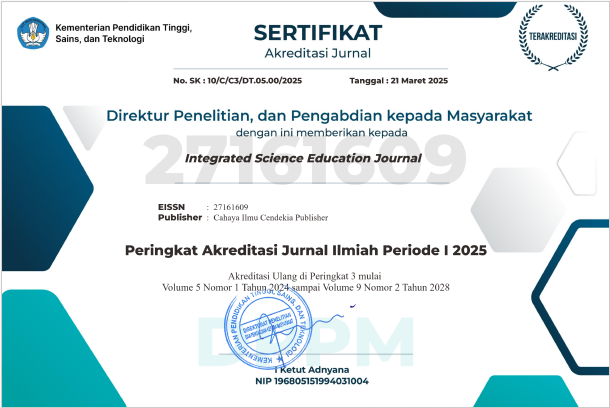The Effectiveness of Using Guided Discovery Learning Models on Student Learning Outcomes on Reaction Rate Materials in Class XI
Abstract
Research Objectives: This study aims to determine the effectiveness of the implementation of the Guided Discovery Learning learning model on the reaction rate material.
Methodology: The research method used is a mix method research method that combines quantitative research and qualitative research. The design used is a quasi-experimental research design with a time-series design without a control class. There is one class that is used as a sample, namely class XI MIPA 6. The sampling technique used is purposive sampling. The research instrument used was an observation sheet on teacher and student activities in carrying out the model and student learning outcomes tests in the form of essays.
Main findings: Based on the results of data analysis, it was found that the effectiveness of using the Guided Discovery Learning Model in terms of student learning outcomes at the first meeting increased compared to the pretest (25.66%, 73.88%), and at the second meeting (73.88%, 74 ,33%). The data is supported by quantitative observation data which shows a good category (76%), and qualitative observation data of the learning process has been carried out well. However, at the third meeting, learning outcomes decreased drastically by around 53.16%. This is relevant to the qualitative data which also shows that the learning process was not carried out well at the third meeting.
Research novelty: The novelty of this research is the use of the Guided Discovery Learning model to see student learning outcomes.
References
Slameto, Belajar dan faktor-faktor yang mempengaruhinya. Jakarta: Rineka Cipta, 2010.
Hakim, Belajar Secara Efektif. Jakarta: Pustaka Pembangunan swadaya nusantara, 2012.
A. Ridwan, Pembelajaran Saintifik untuk Implementasi Kurikulum 2013. Jakarta: PT Bumi Aksara, 2014.
S. Mutoharoh, Pengaruh Model Guided Discovery Learning Terhadap Hasil Belajar Kimia Siswa Pada Konsep Laju Reaksi. Jakarta: UIN Syarif Hidayatullah, 2011.
S. Maryani, Astalini2, and D. A. Kurniawan, “Analysis of Student Needs for Development of Innovative Learning Media E-Module on Linear Equations Mathematical Physics,” Attract. Innov. Educ. J., vol. 4, no. 1, pp. 165–172, 2022.
R. Fitriani, W. A. Putri, E. F. S. Rini, N. H. Sehab, and M. R. Pratiwi, “Pengaruh Kerja Keras Terhadap Hasil Belajar Siswa,” SAP (Susunan Artik. Pendidikan), vol. 5, no. 3, pp. 213–220, 2021.
Kholilah, A. Ramadhanti, R. Fitriani, E. Febri, and M. R. Pratiwi, “Hubungan Kerja Keras Dan Hasil Belajar Fisika Di Sma Negeri 1 Kota Jambi,” J. Sci. Educ. Pract., vol. 4, pp. 41–48, 2020
Sugiyono, Metode Penelitian Kuantitatif, Kualitatif, dan R&D. Bandung: ALFABETA, CV, 2013.
W. Sujarweni, SPSS untuk Penelitian. Yogyakarta: Pustaka Baru Press., 2015.
M. B. Miles and M. A. Huberman, Qualitative Data Analysis 2nd Edition. California: SAGE Publications, Inc, 1994.
R. Fitriani, Astalini, and D. A. Kurniawan, “Studi Ekploratif: Pengembangan Modul Elektronik pada Mata Kuliah Fisika Matematika 1,” Al Ulum Sains dan Teknol., vol. 7, no. 1, pp. 1–9, 2020, doi: 10.31602/ajst.v7i1.5462.
R. Fitriani et al., “Mendeskripsikan Keterampilan Proses Sains Siswa melalui Kegiatan Praktikum Viskositas di SMAN 1 Muaro Jambi,” PENDIPA J. Sci. Educ., vol. 5, no. 2, pp. 173–179, 2021, doi: 10.33369/pendipa.5.2.173-179.
J. W. Creswell, Educational Research: Planning, Conducting, and Evaluation Quantitative and Qualitative Research 4th Edition. Boston: Pearson Education, Inc, 2012.
S. Santoso, SPSS 20 Pengolahan Data Statistik di Era Informasi. Jakarta: PT. Elex Media Komputindo, 2015.
Copyright (c) 2022 Vina Karlina, Rita Asma

This work is licensed under a Creative Commons Attribution-NonCommercial 4.0 International License.
Authors who publish with this journal agree to the following terms:
- Authors retain copyright and acknowledge that the Integrated Science Education Journal is the first publisher licensed under a Creative Commons Attribution 4.0 International License.
- Authors are able to enter into separate, additional contractual arrangements for the non-exclusive distribution of the journal's published version of the work (e.g., post it to an institutional repository or publish it in a book), with an acknowledgment of its initial publication in this journal.
- Authors are permitted and encouraged to post their work online (e.g., in institutional repositories or on their website) prior to and during the submission process, as it can lead to productive exchanges and earlier and greater citation of published work.







.png)
.png)






